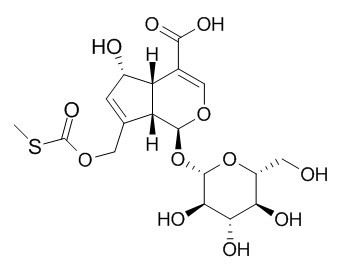Paederosidic acid
Paederosidic acid has significant anti-tumor, anticonvulsant and sedative effects. Paederosidic acid increases brain gamma-aminobutyric acid and decreases glutamic acid in the brain, and it up-regulates expressions of GAD 65, may be a promising future therapeutic agent for treatment of epilepsy.
Inquire / Order:
manager@chemfaces.com
Technical Inquiries:
service@chemfaces.com
Tel:
+86-27-84237783
Fax:
+86-27-84254680
Address:
1 Building, No. 83, CheCheng Rd., Wuhan Economic and Technological Development Zone, Wuhan, Hubei 430056, PRC
Providing storage is as stated on the product vial and the vial is kept tightly sealed, the product can be stored for up to
24 months(2-8C).
Wherever possible, you should prepare and use solutions on the same day. However, if you need to make up stock solutions in advance, we recommend that you store the solution as aliquots in tightly sealed vials at -20C. Generally, these will be useable for up to two weeks. Before use, and prior to opening the vial we recommend that you allow your product to equilibrate to room temperature for at least 1 hour.
Need more advice on solubility, usage and handling? Please email to: service@chemfaces.com
The packaging of the product may have turned upside down during transportation, resulting in the natural compounds adhering to the neck or cap of the vial. take the vial out of its packaging and gently shake to let the compounds fall to the bottom of the vial. for liquid products, centrifuge at 200-500 RPM to gather the liquid at the bottom of the vial. try to avoid loss or contamination during handling.
Environ Toxicol.2024, 39(4):2417-2428.
Curr Res Food Sci.2024, 9:100827.
Phytomedicine.2023, 117:154929.
Pak J Pharm Sci.2019, 32(6):2879-2885
Research Square2024, rs-4398438
Comp. & Mathematical Methods in Med.2022, 5475559.
Current Topics in Nutraceutical Research2021, 19(1),p90-105.
Advances in Traditional Medicine 2021, 21:779-789.
UDC.2020, 19(4).
Pharmaceutical Chemistry Journal2019, 52(12):986-991
Related and Featured Products
Chem Biol Interact. 2017 May 1;269:33-40.
Antitumor activity of paederosidic acid in human non-small cell lung cancer cells via inducing mitochondria-mediated apoptosis.[Pubmed:
28185768]
This study was aimed to investigate antitumor activity of Paederosidic acid (PA) in human non-small cell lung cancer cells and explore the related mechanisms.
METHODS AND RESULTS:
The anti-proliferative effects of PA on A549 cells were evaluated by MTT method and the IC50 values were calculated. Furthermore, the PA-induced apoptosis in A549 cells was determined by fluorescence microscope via staining with DAPI and by flow cytometer via staining with FITC conjugated Annexin V/PI. The expression of apoptosis-related or signaling proteins was investigated by Western blotting. Our results demonstrated that PA showed significant anti-tumor activity on lung cancer in vitro; the mechanisms were involved in inducing mitochondria-mediated apoptosis via up-regulation of caspase-3, caspase-8, caspase-9, Bid, Bax, down-regulation of Bcl-2 and stimulating the release of Cyto-C from mitochondria. In addition, JNK phosphorylation levels significantly increased concomitantly with decrease in Akt phosphorylation after treatment with PA in A549 cells. However, JNK siRNA-transfected cells diminished PA-induced caspase-3, 8 and 9, Bid and Bax activaton while enhanced the Bcl-2 activation.
CONCLUSIONS:
Collectively, these results indicated that PA-induced JNK activation played an important functional role in apoptosis.
Pharmacol Biochem Behav. 2013 Oct;111:97-101.
Anticonvulsant and sedative effects of paederosidic acid isolated from Paederia scandens (Lour.) Merrill. in mice and rats.[Pubmed:
24029464]
This study was designed to evaluate the anticonvulsant and sedative effects of Paederosidic acid isolated from Paederia scandens (Lour.) Merrill. in mice and rats.
METHODS AND RESULTS:
In the present study, anticonvulsant activities of Paederosidic acid were evaluated by maximal electroshock and pentylenetetrazole-induced seizures in male mice. Then, pentobarbital sodium-induced sleeping time and locomotor activity tests in mice were used to evaluate the sedative effects of Paederosidic acid. Finally, the mechanism of Paederosidic acid was explored by evaluating the contents of Glu and GABA in the brain, and Western blot was used to measure GAD65 expression in the mouse brain. Paederosidic acid (5, 10, 20, and 40 mg/kg, ip) had significant anticonvulsant and sedative effects. Moreover, Paederosidic acid increased brain gamma-aminobutyric acid and decreased glutamic acid in the brain, and it up-regulated expressions of GAD 65.
CONCLUSIONS:
In conclusion, our results suggest that Paederosidic acid may be a promising future therapeutic agent for treatment of epilepsy.



